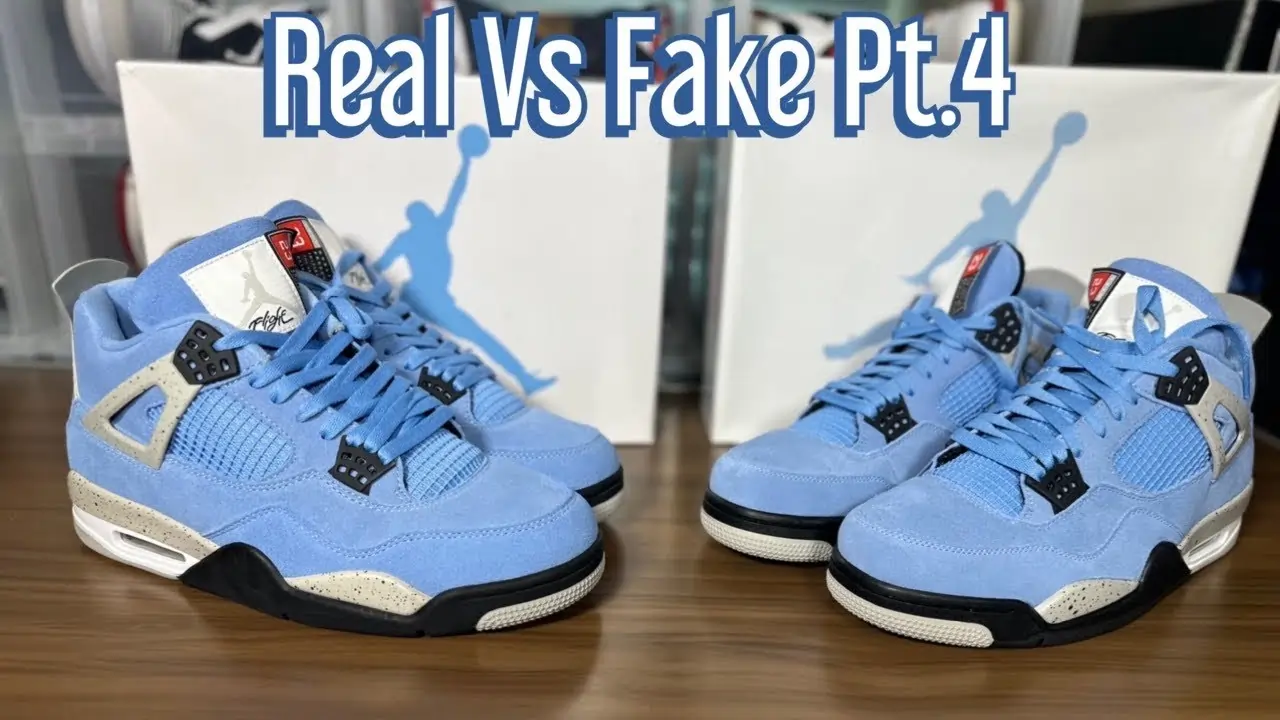The Air Jordan 4 is one of the most iconic sneakers ever released by Nike and Jordan Brand. First introduced in 1989, the Jordan 4 quickly became a cultural symbol, loved for its bold design, unique mesh panels, visible Air cushioning, and legendary collaborations. But because of its popularity, the Jordan 4 has also become one of the most replicated sneakers on the market. From budget fakes to high-quality “UA” (Unauthorized Authentic) replicas, spotting the difference between a real Jordan 4 and a fake pair can be tricky—even for sneakerheads.
In this guide, we’ll break down a comprehensive Jordan 4 legit check with step-by-step details on how to distinguish authentic pairs from replicas, whether you’re buying from a store, reseller, or online marketplace.
Why You Need to Legit Check Jordan 4s
The resale market for sneakers is booming. Some limited-edition Jordan 4s, such as the Jordan 4 Travis Scott Cactus Jack, Jordan 4 Off-White Sail, or the Jordan 4 Retro University Blue, sell for hundreds or even thousands of dollars on StockX, GOAT, or Flight Club. This high demand has fueled counterfeiters to flood the market with replicas.
Without knowing what to look for, you could easily end up paying resale prices for a fake pair. A proper legit check ensures you’re investing in authentic sneakers that maintain value, quality, and collectability.
Step 1: Inspect the Box and Packaging
The first sign of authenticity begins with the packaging.
-
Box Shape & Quality: Real Jordan 4 boxes are sturdy, with sharp edges and premium cardboard. Fake boxes often feel flimsy, with poorly cut corners.
-
Jumpman Logo & Text: Authentic Jordan boxes feature a cleanly printed Jumpman with correct proportions. On fakes, the Jumpman may look too skinny, too fat, or have messy lines.
-
Label Sticker: The size tag on the side of the box should be perfectly aligned, with consistent font and spacing. Fake boxes often use bold or incorrect fonts.
-
Lid & Tissue Paper: Originals come with speckled paper or branded tissue. Replicas sometimes use plain white or low-quality paper.
Pro tip: Compare the SKU number on the box with the SKU number on the inside label of the sneaker—it should always match.
Step 2: Check the Shape and Silhouette
The overall shape of the sneaker is one of the biggest giveaways.
-
Heel Shape: Authentic Jordan 4s have a slightly curved heel that tapers naturally. Fake pairs often have a bulkier, straighter, or overly slanted heel.
-
Toe Box: On real pairs, the toe box sits low and sleek. Many replicas have a puffier or higher toe box that changes the sneaker’s profile.
-
Sole Proportions: The midsole and outsole of authentic 4s are consistent in thickness and placement, while fakes often look “off” when compared side by side.
Step 3: The Jumpman Logo
The Jumpman logo is one of the most important indicators in any Jordan legit check.
-
Tongue Tag Jumpman: On authentic Jordan 4s, the Jumpman is perfectly embroidered with visible fingers, shoelaces, and correct proportions. Replicas often have deformed arms, thick stitching, or missing details.
-
Heel Tab Jumpman: On the back of the sneaker, check the Jumpman carefully. On real pairs, the logo is centered, sharp, and raised with high-quality material. Fake logos can look stretched, skinny, or poorly detailed.
Step 4: The Tongue and Inside Tag
-
Tongue Height & Shape: Authentic Jordan 4 tongues stand tall with a structured shape. Fake tongues are often shorter, uneven, or floppy.
-
Inside Size Tag: The size tag inside should have clear, sharp printing with accurate font. Check the production dates—fake pairs often use unrealistic or random dates.
Step 5: Mesh Panels
One of the signature elements of the Jordan 4 is the mesh cage on the side panels and tongue.
-
Authentic Pairs: The mesh is tightly woven, durable, and placed at a consistent angle.
-
Fake Pairs: The mesh may look too wide, too loose, or even rubbery instead of firm. The angle of the mesh diamond shapes is also often incorrect.
Step 6: Heel Tab & Back Details
Another clear sign is the heel tab at the back of the sneaker.
-
Authentic Heel Tabs: When pressed, they snap back firmly.
-
Replica Heel Tabs: They are often flimsy, bend easily, and may not return to their original position.
Also check the placement of the logo on the heel tab—it should be perfectly centered.
Step 7: Midsole & Paint Job
-
Paint Lines: Jordan 4s have smooth, crisp paint lines on the midsole. Fake pairs usually have messy or uneven paint, with bleeding edges.
-
Air Unit: Look through the visible Air bubble. Authentic pairs have clean, transparent Air units with visible “pillars.” Fake ones often look cloudy or inconsistent.
Step 8: Insole and Stitching
-
Insole Logo: Real pairs have a sharp, well-printed Nike Air or Jumpman logo on the insole. Replicas may fade quickly or look misaligned.
-
Stitching Quality: Authentic Jordans have consistent, even stitching throughout. Fakes often have loose threads, crooked lines, or sloppy craftsmanship.
Step 9: Smell and Material Quality
It might sound odd, but the smell test is real. Authentic Jordans have a distinct “new sneaker” scent from quality leather and glue. Fakes often smell strongly of cheap chemicals or plastic.
Also check the materials:
-
Leather & Suede: Authentic Jordan 4s use premium materials that feel smooth, sturdy, and high-quality.
-
Replicas: Often feel plasticky, stiff, or too soft.
Step 10: Compare With Legit Sources
If you’re still unsure, compare your pair with images from:
-
Nike SNKRS app
-
Official Jordan Brand website
-
Trusted marketplaces like StockX or GOAT
Side-by-side comparison can highlight even the smallest differences.
Pro Tips for Avoiding Fake Jordan 4s
-
Buy from Trusted Retailers – Stick to Nike, Foot Locker, or reputable sneaker stores.
-
Use Legit Check Services – Apps like CheckCheck or platforms like StockX/GOAT offer authentication.
-
Be Cautious of Price – If the deal looks too good to be true, it probably is.
-
Ask for Detailed Photos – When buying online, request close-ups of the tongue, heel, midsole, and size tags.
-
Educate Yourself – Follow sneaker legit check communities on Reddit or Instagram for up-to-date comparisons.
Final Thoughts
The Air Jordan 4 US Replica is more than just a sneaker—it’s a piece of basketball history and a cultural icon. Unfortunately, its popularity has made it one of the most counterfeited sneakers worldwide. Knowing how to spot the differences between real and fake Jordan 4s can save you from disappointment and financial loss.
From the box and packaging to the Jumpman logo, mesh panels, stitching, and materials, every detail matters in a proper legit check. The more pairs you examine, the sharper your eye becomes at spotting inconsistencies.
Whether you’re a collector, reseller, or casual sneaker fan, this guide ensures that when you wear a pair of Jordan 4s, you can be confident they’re the real deal.




